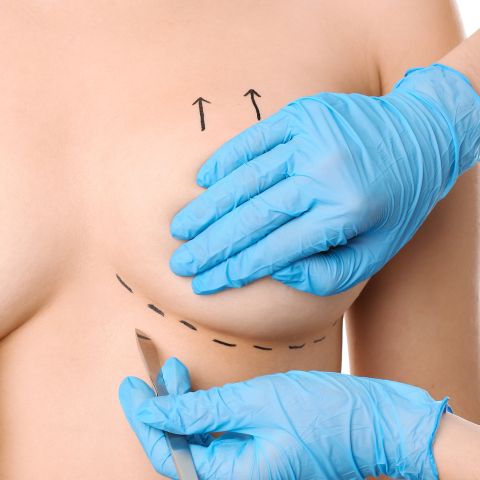

Breast Reduction, medically known as "reduction mammoplasty", is a surgical procedure aimed at reducing the size of overly large breasts to achieve a breast size more in proportion with the body, alleviating the discomfort associated with excessively large breasts. The surgery involves removing excess breast tissue, fat, and skin to achieve the desired breast size and shape. It can also involve reshaping the breast and repositioning the nipple and areola to a more natural, elevated position.
Apart from the aesthetic improvements, breast reduction surgery can provide relief from physical symptoms like back, neck, and shoulder pain, skin irritations beneath the breast crease, and limitations in physical activity due to the weight and size of the breasts.
Pros of Breast Reduction:
- Physical Relief: Reducing the size of large breasts can alleviate pain in the neck, shoulders, and back. It can also reduce skin irritations and rashes under the breasts.
- Enhanced Aesthetics: The procedure can lead to more proportionate breasts that fit better with the individual's body frame.
- Increased Self-confidence: Many patients experience a boost in self-esteem after the procedure, feeling more comfortable in clothing and social situations.
- Improved Physical Activity: With smaller and lighter breasts, individuals often find it easier to engage in physical activities without discomfort or constraint.
- Correction of Breasts Asymmetry: The procedure can be used to make the breasts more symmetrical if one is larger than the other.
Cons of Breast Reduction:
- Scarring: Like any surgical procedure, breast reduction can leave scars. However, these usually fade over time and can be strategically placed to be less noticeable.
- Potential Complications: As with any surgery, there's a risk of complications such as infection, bleeding, and adverse reactions to anesthesia.
- Possible Loss of Sensation: Some patients may experience a temporary or permanent loss of sensation in the nipples or breasts.
- Breastfeeding Challenges: The procedure may affect the ability to breastfeed, as some of the milk ducts might be removed or affected during surgery.
- Need for Further Surgery: Over time, if there are changes in weight or the effects of aging, there may be a desire or need for additional breast surgeries.
- Cost: The procedure can be expensive, especially if not covered by insurance.
Breast Reduction, Breast Lift, and Breast Augmentation are all surgical procedures that modify the appearance of the breasts, but each has distinct goals and outcomes:
1. Breast Reduction:
- Primary Goal: To decrease the size and volume of the breasts.
- Reason for Procedure: Typically chosen by individuals who experience physical discomfort or pain due to overly large breasts, or those who feel their breast size is not proportionate to their body.
- Outcome: Reduced breast size with alleviation of associated symptoms, and a lifted appearance as excess skin is also removed.
2. Breast Lift (Mastopexy):
- Primary Goal: To raise sagging or drooping breasts by removing excess skin and reshaping the breast tissue.
- Reason for Procedure: Often chosen by individuals whose breasts have lost their youthful shape and firmness due to factors like aging, pregnancy, weight changes, or gravity.
- Outcome: Elevated and reshaped breasts without a significant change in size. However, some minor reduction or augmentation might be incorporated to achieve the desired contour.
3. Breast Augmentation:
- Primary Goal: To increase the size and/or improve the shape of the breasts.
- Reason for Procedure: Typically chosen by individuals who want larger breasts, want to restore volume lost due to pregnancy or weight loss, or want to achieve a more balanced breast size.
- Outcome: Enhanced breast size using implants or, in some cases, fat transfer. The breasts appear fuller and more pronounced.
In essence, while all three surgeries modify the breasts, they cater to different needs:
- Reduction primarily decreases size.
- Lift addresses shape and position without significantly altering size.
- Augmentation primarily increases size.
Determining whether you're a good candidate for breast reduction involves several factors, both physical and psychological. Here are some general criteria that may indicate you're a suitable candidate for the procedure:
- Physical Discomfort: You experience physical symptoms like back, neck, or shoulder pain due to the weight of your breasts.
- Skin Issues: You have skin irritations, rashes, or infections beneath the breast crease as a result of the size and sag of your breasts.
- Limitation in Activities: Your breast size restricts your physical activity, making it uncomfortable or painful to participate in certain sports or exercises.
- Clothing Concerns: You find it challenging to fit into clothing or bras due to your breast size, or you feel self-conscious about the attention your breast size attracts.
- Breast Proportion: You feel that your breasts are not in proportion to the rest of your body.
- Emotional Distress: You experience psychological distress, low self-esteem, or body image concerns related to the size of your breasts.
- Asymmetry: One breast is significantly larger than the other, causing imbalance and discomfort.
- Non-smoking: You don't smoke, or are willing to quit prior to the surgery and throughout the recovery, as smoking can interfere with the healing process.
- Good Health: You are in good general health, without any untreated chronic medical conditions that might complicate surgery or recovery.
- Realistic Expectations: You have realistic expectations about the results, the potential scars, and the recovery process.
- No Immediate Plans for Pregnancy: While it's possible to breastfeed after a breast reduction, it's advisable to wait if you have immediate plans for pregnancy, as it can affect the surgical outcome.
- Commitment to Post-Op Care: You are ready to follow post-operative care guidelines, attend follow-up appointments, and ensure proper healing.
Breast reduction, also known as reduction mammoplasty, is a surgical procedure designed to reduce the size of large breasts while improving their shape and position. The specific techniques can vary based on the individual's anatomy and surgeon's preference. Here's a general overview of how the procedure is performed and the typical timeframe:
1. Anesthesia: The first step in any surgical procedure is the administration of anesthesia. Breast reduction is typically performed under general anesthesia, ensuring that the patient is comfortable and pain-free throughout the operation.
2. Incisions: There are several types of incision techniques that may be used, depending on the degree of reduction, the patient's anatomy, and surgeon preference. Common methods include:
- Circular Pattern: Around the areola.
- Keyhole Pattern: Around the areola and vertically down to the breast crease.
- Anchor Pattern: Around the areola, vertically down from the areola to the breast crease, and horizontally along the breast crease.
3. Removing Tissue and Reshaping: Once the incisions are made, the surgeon will remove excess breast tissue, fat, and skin to reduce the size of the breasts. The remaining tissue is then reshaped, and the nipple and areola are repositioned to a more youthful height. In some cases, the areola size may be reduced.
4. Closing the Incisions: After reshaping, the incisions are brought together to reshape the smaller breast. Sutures are layered deep within the breast tissue to support the newly shaped breasts. Incisions lines are permanent but will fade and improve over time.
5. Recovery: After the procedure, the breasts are bandaged or placed in a surgical bra. Drainage tubes might be used to remove excess fluid and are typically removed within a few days.
General Timeframe:
- Surgery Duration: The surgery itself typically lasts 2 to 4 hours, depending on the extent of reduction and the technique used.
- Hospital Stay: Patients may go home the same day (outpatient) or might require an overnight hospital stay.
- Recovery Period: Most patients can return to non-strenuous work within 1-2 weeks post-surgery. However, physical activity, especially involving the upper body, may be restricted for up to 6 weeks. Complete healing and settling of the breasts might take several months.
Recovery after a breast reduction procedure can vary based on individual factors, but here's a general overview of what most patients can expect:
Immediate Post-Operative Period:
- After the surgery, you'll be taken to a recovery area where you'll be closely monitored. Depending on the extent of the surgery and individual circumstances, you might be released the same day or require an overnight stay in the hospital or surgical center.
- Your breasts will be bandaged or wrapped in a surgical bra to support healing. Drainage tubes might be placed to help remove excess fluid or blood.
First Few Days:
- Swelling, bruising, and discomfort are common but should gradually diminish. Your surgeon will prescribe pain medication to help manage any discomfort.
- It's essential to get up and walk around at intervals to promote circulation and prevent blood clots.
- You should rest and avoid any strenuous activities. Sleeping in an elevated position can help reduce swelling.
First Few Weeks:
- The surgeon may advise wearing a supportive bra 24/7 to help shape the breasts and support healing.
- Most stitches are dissolvable, but if you have non-dissolvable ones, they'll typically be removed within 1-2 weeks.
- Swelling will continue to decrease, and the shape of your breasts will start to settle.
- Most patients can return to non-strenuous work within 1-2 weeks. However, heavy lifting or vigorous activities should be avoided for at least 4-6 weeks.
Long-Term Recovery:
- Scars will be reddish initially but will fade over time. They may never disappear entirely but should become less noticeable.
- Regular follow-up visits with your surgeon will be necessary to monitor your progress.
- It's essential to report any sudden swelling, fever, or unusual discharge to your surgeon as these could be signs of an infection or other complications.
- Once healed, maintaining a stable weight will help sustain the results. Significant weight fluctuations can alter the breast size and shape.
Remember, individual experiences can vary, so it's crucial to follow your surgeon's specific instructions for post-operative care to ensure optimal healing and results.
Caring for your breasts after a breast reduction procedure is crucial to ensure a smooth recovery and achieve the best possible results. Here are some general guidelines:
Supportive Bra: Wear a surgical or supportive bra as recommended by your surgeon. This helps minimize swelling, provides support, and assists in shaping the breasts during the healing process.
Incision Care:
- Keep the incision areas clean and dry.
- If you have non-dissolvable sutures, they will typically be removed within 1-2 weeks post-op.
- Your surgeon may recommend specific creams or ointments to apply to the scars to aid healing and reduce scarring visibility.
Swelling and Pain Management:
- Use cold compresses to manage swelling, but always wrap them in a cloth to avoid direct contact with the skin.
- Take prescribed pain medications as directed. Inform your surgeon if you experience severe or prolonged pain.
Activity Restrictions:
- Avoid strenuous activities and heavy lifting for the time recommended by your surgeon, typically 4-6 weeks.
- Start with light walking soon after surgery to promote blood circulation.
Sleeping Position: Sleep on your back with your upper body slightly elevated for the first few weeks. This can help reduce swelling and ensures that pressure is not placed on the breasts.
Avoid Smoking: Smoking can hinder the healing process and increase the risk of complications. If you smoke, it's advisable to quit at least a few weeks before and after the surgery.
Stay Hydrated and Eat Nutritious Foods: Proper hydration and a balanced diet can aid in the healing process.
Follow-up Appointments: Attend all scheduled post-operative appointments so your surgeon can monitor your recovery and address any concerns.
Be Observant: Monitor your breasts for any signs of complications, such as increased redness, warmth, unusual swelling, pus, or if the skin feels unusually hot to touch. Notify your surgeon if you observe any of these symptoms.
Protect Scars from Sun: Once healed, it's crucial to protect scars from direct sunlight for at least a year to prevent them from darkening. Use sunscreen or clothing to cover the area.
Always remember that these are general guidelines. Your surgeon will provide specific instructions tailored to your situation. Following these recommendations closely ensures a smoother recovery and optimal outcomes.
Turkey has rapidly gained a reputation for its high-quality medical services combined with competitive pricing, particularly in the realm of aesthetic surgery. The driving factors behind this affordability include lower labor and operational costs, competitive medical markets, and a high volume of procedures performed, which offsets overhead expenses.
Western Europe: In countries such as the UK, France, and Germany, the cost of a breast reduction procedure can be considerable. Prices typically range from €5,000 to €10,000 or even more, depending on the clinic, the surgeon's expertise, and the intricacies of the operation.
USA: The United States sees even higher prices for breast reduction. Depending on various factors like geographical location, surgeon's reputation, and the complexity of the procedure, costs can fluctuate between $6,000 to $12,000 or more. This range often excludes additional fees like anesthesia, operating room facilities, or other related expenses.
Turkey: In contrast, Turkey emerges as an economical option without compromising on quality. The cost for a breast reduction in Turkey can vary between €2,000 to €4,500. The all-inclusive packages often offered by Turkish clinics might encompass surgeon fees, hospital stay, post-operative care, and sometimes even accommodations. For many international patients, the combined allure of cost savings and a chance to explore the rich Turkish culture and history makes it an appealing choice.
Choosing Elara Medical Tourism for your Breast Reduction procedure in Turkey offers a seamless blend of world-class medical care, affordability, and a personalized approach. Here's why:
1. Experienced Medical Professionals: Elara Medical Tourism collaborates with some of Turkey's most renowned and experienced surgeons who are proficient in breast reduction and other aesthetic procedures. Their expertise ensures you receive the highest standard of care.
2. Accredited Facilities: We partner with state-of-the-art hospitals and clinics that are internationally accredited. This guarantees that you will be treated in facilities that meet global standards in terms of equipment, hygiene, and safety protocols.
3. Affordable Packages: Elara Medical Tourism understands the significance of providing value for money. Our comprehensive packages are not only affordable but also transparent, with no hidden costs. These packages often include the procedure, post-operative care, and sometimes accommodations and local transportation.
4. Personalized Care: Every patient is unique, and so are their medical needs. Our team ensures a personalized treatment plan tailored to your specific requirements and desired outcomes.
5. Cultural Experience: Turkey is a country rich in history and culture. While you're here for your procedure, Elara can also arrange for cultural and sightseeing experiences, making your medical trip even more memorable.
6. 24/7 Assistance: Our dedicated team is available around the clock to assist you during your stay in Turkey. From pre-arrival planning to post-operative care, we are with you at every step.
7. Language Assistance: Communication is crucial, especially when it's about medical procedures. Our multilingual staff ensures that there's no language barrier, making your experience smooth and stress-free.
Trust Elara Medical Tourism to provide a holistic and comfortable experience, combining medical excellence with the warmth of Turkish hospitality.


